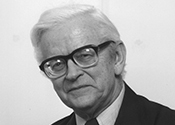Sir John Kendrew, former Director General, passed away on 23 August 1997, aged 80.
John Kendrew’s death on August 23, 1997, was a great loss for European molecular biology and for EMBL. Without his years of efforts to win support and funding for the Laboratory, EMBL probably would not exist today. He is remembered fondly and with great respect by the scientists who worked at EMBL during his administration, and by the members of the newer generation who were fortunate enough to see him in the Laboratory during the symposium celebrating his eightieth birthday in April 1997.
Kendrew was born in Oxford in 1917. In 1945, after studies in Chemistry at Trinity College in Cambridge and service during World War Two, he took a research position under Max Perutz at the Cavendish Laboratory in Cambridge. Perutz convinced him to take on a difficult project using crystallographic techniques to study the haemoglobin protein in sheep.
“Today’s researchers can hardly imagine how courageous Kendrew’s decision was then to take up protein crystallography,” Perutz wrote in a tribute in 1996. “I had no research students because responsible dons advised graduates against joining such a forlorn undertaking.” The project was to determine the structure of haemoglobin using X-rays- a particularly ambitious task, because at that time no protein structure had been solved, and haemoglobin was a large molecule. Kendrew soon turned his attention to myoglobin, a much smaller protein, and this work led to a Nobel Prize in Chemistry in 1962 which he would share with Perutz (who was honored for his work on haemoglobin).
Tissues from the horse heart refused to provide Kendrew with myoglobin that would produce protein crystals, but meat from a sperm whale, obtained by Perutz, produced crystals which yielded to X-ray analysis. It took several years to analyze the data, but in the end Kendrew was able to build the first atomic model of a protein.
In 1962, John Kendrew became Deputy Director of the new Laboratory of Molecular Biology at the MRC, a post which he held until 1974. In 1963 he was knighted and awarded the Order of the British Empire. He founded and served as editor-in-chief of the Journal of Molecular Biology, the most important publication in the field at that time. He helped to found the European Molecular Biology Organisation (EMBO) in 1963; thereafter, as a special EMBO project, he launched a campaign to convince the governments of Europe to establish an international laboratory for molecular biology based on the model of CERN in Switzerland. EMBL finally became a reality in 1974, and; Kendrew was appointed as its first Director-General.
Kendrew called his time at EMBL the most interesting period of his life. “Starting something from zero presents a rather unusual opportunity” he said. “You have so much freedom to be creative.”
“Kendrew’s philosophy was that small is better” says Kai Simons, who came to the EMBL as one of its first group leaders in 1975. “Small groups have to depend on each other, and this creates the kind of synergy which is necessary to do high-quality science.” Kendrew’s vision has left a permanent mark on the way the Laboratory works: the basis of EMBL research is still small groups with a great deal of independence.
After his retirement from EMBL in 1982, Kendrew served as a Trustee of the British Museum, President of the International Council of Scientific Unions, and President of St. John’s College in Oxford, and was involved in the advisory committees of several important scientific institutions-including AC-EBI, the committee appointed by F. C. Kafatos, the third Director-General of EMBL, when he assumed office in 1993. The purpose of this group was to help Kafatos formulate detailed plans for the latest EMBL Outstation, the European Bioinformatics Institute in Hinxton.
“In this committee” said Kafatos, “Kendrew was able to contribute to our planning in the field of Bioinformatics, just as he had in 1980, when he decided to start the EMBL nucleotide database-the first biological sequence database in the world. His appointment was also a token of thanks to him personally, and to the visionary generation to which he belonged. That generation conceived both EMBL and EMBO in the 1960’s, and left us with the immense responsibility to complete and deepen the internationalization of molecular biology in Europe in the present changed circumstances.”
Taken from the EMBL Annual Report, 1997
